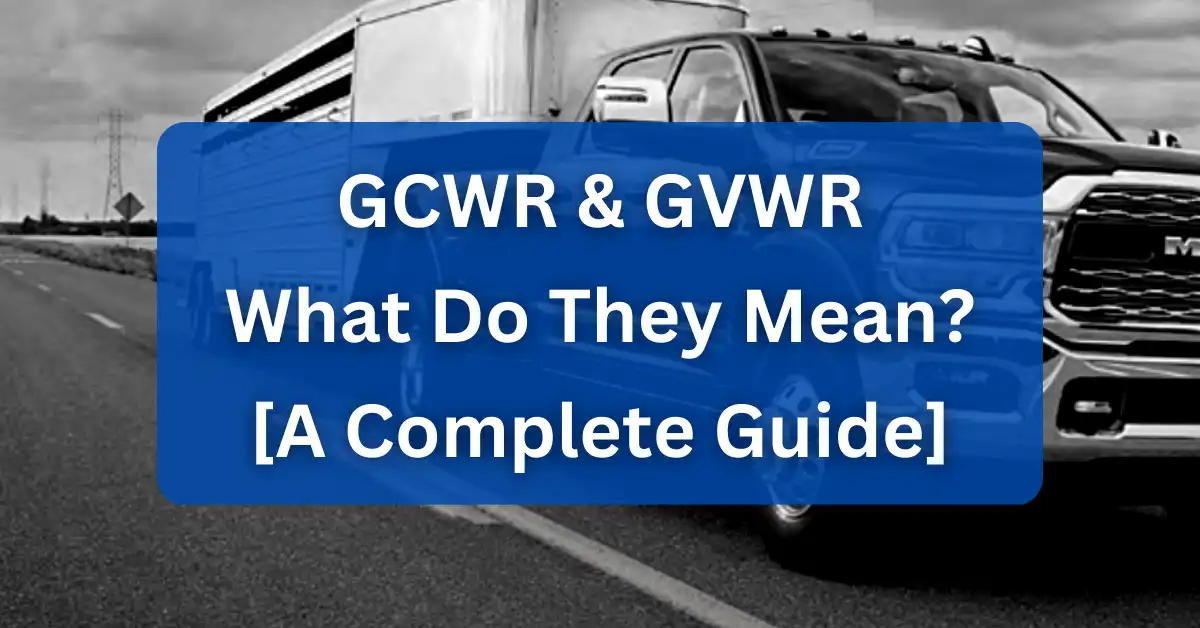GCWR vs GVWR: What Do They Mean? [A Complete Guide]
Hey there! Are you ready to learn about GCWR vs GVWR?
These might seem like confusing acronyms, but trust me, they’re important for you to understand if you own or operate a vehicle. Let’s dive in!
So, first things first. GCWR stands for Gross Combined Weight Rating, and GVWR stands for Gross Vehicle Weight Rating. These are both weight limits set by vehicle manufacturers to ensure the safe and efficient operation of their vehicles.
GCWR refers to the maximum weight that a vehicle can tow, including the weight of the vehicle, its payload, and the weight of the trailer and its contents.
On the other hand, GVWR is the maximum weight limit that a vehicle can carry, including its weight and payload.
So, in this article, we’re going to provide you with a complete guide to GCWR and GVWR.
We’ll explain their differences, how they impact towing capacity, and the legal and safety considerations you need to keep in mind.
By the end of this article, you’ll have a solid understanding of these weight ratings and how they apply to your vehicle.
So let’s dive in!
What is GCWR?
Have you ever wondered how much weight your vehicle can safely tow? That’s where GCWR comes in! Let’s take a closer look at GCWR.
Definition of GCWR
As mentioned earlier, GCWR, or Gross Combination Weight Rating, is a weight limit that determines the maximum weight a vehicle and its attached trailer can safely and legally carry together.
This weight limit includes the weight of the vehicle, the weight of the trailer, and the weight of any cargo, passengers, or accessories that are being transported.
GCWR Calculations
The GCWR calculation formula takes into account the weight of the vehicle, the weight of the trailer, and the weight of any cargo or passengers being transported.
The GCWR calculation formula is:
GCWR = GVWR + Trailer Weight + Cargo + Passengers
where:
- GVWR is the Gross Vehicle Weight Rating, or the maximum weight limit for the vehicle alone
- Trailer Weight is the weight of the trailer being towed
- Cargo is the weight of any additional cargo being carried
- Passengers is the weight of any passengers in the vehicle
It’s important to keep in mind that any extra body or cosmetic additions to your vehicle will add weight to the overall calculation of GCWR.
So, when calculating the GCWR, make sure to ADD the weight of any additional equipment or modifications that you have made to your vehicle.
This will ensure that you have an accurate calculation and avoid overloading your vehicle.
Example Calculation:
Let’s say that you have a pickup truck with NO extra body additions and has a GVWR of 6,000 pounds and you want to tow a trailer that weighs 2,500 pounds.
You also plan to carry 500 pounds of cargo and two passengers weighing 300 pounds total.
We can calculate the GCWR as follows:
- GCWR = 6,000 + 2,500 + 500 + 300
- GCWR = 9,300 pounds
Therefore, the GCWR for this setup is 9,300 pounds.
It is important to note that exceeding the GCWR limit can lead to decreased vehicle performance, increased wear and tear on the vehicle, and safety risks such as brake failure, tire blowouts, and loss of control.
Therefore, it is essential to follow the GCWR limit to ensure safe and efficient operation of your vehicle while towing.
To determine the GCWR limit of your vehicle, you can refer to the owner’s manual for the specific make and model.
Additionally, our website (TowEngine.com) has detailed articles written by experts in the field for each type of vehicle, including trucks, SUVs, and vans, that provide information on Towing Capacities, Payload Capacities, GCWR limits, Charts, and other towing recommendations.
These articles can be a helpful resource for understanding the towing capacity and limitations of your particular vehicle.
What is GVWR?
Alright, let’s dive into what GVWR is all about!
Definition of GVWR
GVWR stands for Gross Vehicle Weight Rating, and it’s essentially the maximum weight that a vehicle is legally allowed to weigh when fully loaded with passengers, cargo, and fuel.
This includes the weight of the vehicle itself, as well as any passengers, luggage, or other items being carried.
GVWR Calculations
To calculate the GVWR of a vehicle, you’ll need to know a few key pieces of information.
First, you’ll need to know the weight of the vehicle when it’s empty or “unladen.” This is sometimes referred to as the “curb weight” or “base weight” of the vehicle.
You can usually find this information in the owner’s manual or on a sticker inside the driver’s door.
Next, you’ll need to add up the Payload that the vehicle will be carrying.
This includes the weight of the driver, any passengers, and any luggage or other items that will be loaded into the vehicle. It also includes the weight of the fuel that will be in the tank.
The GVWR calculation formula is:
GVWR = Curb Weight + Payload
where:
- Curb weight refers to the weight of a vehicle with a full tank and all the usual gear, but without any passengers or cargo – it’s the closest thing you’ll get to the actual weight of the vehicle.
- Payload refers to the weight of any cargo, passengers, or other items carried by the vehicle.
Example Calculation:
Let’s say you’re planning a road trip with your family and you want to make sure your vehicle can safely carry everyone and their luggage.
You have a minivan that has a curb weight of 4,000 pounds, and the owner’s manual says the GVWR is 6,000 pounds.
First, you need to figure out how many payloads the van can carry.
You have 5 passengers, including yourself, and everyone will have a suitcase and a backpack. You estimate that each suitcase weighs around 40 pounds and each backpack weighs around 10 pounds.
So, the total Payload weight would be:
(5 passengers x 150 pounds per passenger) + (5 suitcases x 40 pounds per suitcase) + (5 backpacks x 10 pounds per backpack) = 1,000 pounds
Next, you use the GVWR calculation formula:
- GVWR = Curb Weight + Payload GVWR
- GVWR = 4,000 pounds + 1,000 pounds
- GVWR = 5,000 pounds
In this case, the GVWR of 5,000 pounds is well below the maximum GVWR of 6,000 pounds listed in the owner’s manual.
That means you can safely carry all of your passengers and their luggage without overloading the vehicle.
To determine your vehicle’s GVWR, consult your owner’s manual or check out our website (TowEngine.com), where we provide detailed articles with towing and payload recommendations for a variety of vehicles.
By following these weight limits and other towing recommendations, you can ensure the safe and efficient operation of your vehicle.
Understanding GCWR and GVWR for Towing
If you’re planning on towing something with your vehicle, understanding GCWR and GVWR is crucial for ensuring safe and efficient operation.
Both weight limits have a direct impact on your vehicle’s towing capacity, which means exceeding them can result in decreased performance, increased wear and tear on your vehicle, and safety risks.
It’s important to keep in mind that several factors can affect your vehicle’s towing capacity, including the engine size, transmission, suspension, brakes, tires, and cooling system.
These factors can vary from vehicle to vehicle, which means it’s important to determine your specific vehicle’s towing capacity before towing anything.
So, how can you determine your vehicle’s towing capacity?
The best way is to refer to your vehicle’s owner’s manual or consult with a reputable dealer or mechanic.
These resources can provide you with the most accurate and up-to-date information on your vehicle’s towing capacity, as well as any other towing recommendations.
By understanding GCWR and GVWR, as well as the factors that affect towing capacity, you can ensure the safe and efficient towing operation of your vehicle.
Always follow these weight limits and other towing recommendations to prevent overloading, avoid legal and safety consequences, and ensure the safe and efficient operation of your vehicle.
Legal and Safety Considerations
Hey there! We’re almost at the end of our discussion on GCWR and GVWR. Let’s talk about the legal and safety considerations of these weight limits.
First of all, it’s really important to follow the GCWR and GVWR limits set by the vehicle manufacturer. This ensures the safe and legal operation of your vehicle.
Exceeding these weight limits can result in fines, penalties, and even legal liability in the event of an accident.
If you exceed the GCWR and GVWR limits, you could face fines and penalties from law enforcement agencies.
Insurance companies may even deny coverage in the event of an accident caused by overloading.
That’s definitely not something you want to deal with!
Aside from the legal consequences, exceeding these weight limits can also lead to safety risks.
It can cause increased wear and tear on the vehicle, decreased performance, and safety risks such as loss of control, brake failure, and tire blowouts.
These can be really dangerous situations, so it’s important to make sure you’re not exceeding the weight limits.
Overall, following the GCWR and GVWR limits is really important for your safety, and the safety of others, and to avoid any legal trouble.
So make sure you’re aware of your vehicle’s weight limits and always stay within them.
Conclusion
Well, folks, that wraps up our discussion on GCWR and GVWR.
We hope this article has provided you with a clear understanding of these weight limits and their impact on towing capacity, legal and safety considerations, and the overall safe operation of your vehicle.
It’s important to remember that exceeding GCWR and GVWR can result in fines, penalties, and even legal liability in the event of an accident.
Safety risks such as decreased performance, brake failure, and tire blowouts can also arise from overloading your vehicle.
To determine your vehicle’s GCWR, GVWR, and towing capacity, refer to the owner’s manual or explore our website.
We hope you found this article informative and helpful. Stay safe on the road!
Explore Capacities by Vehicle Make

